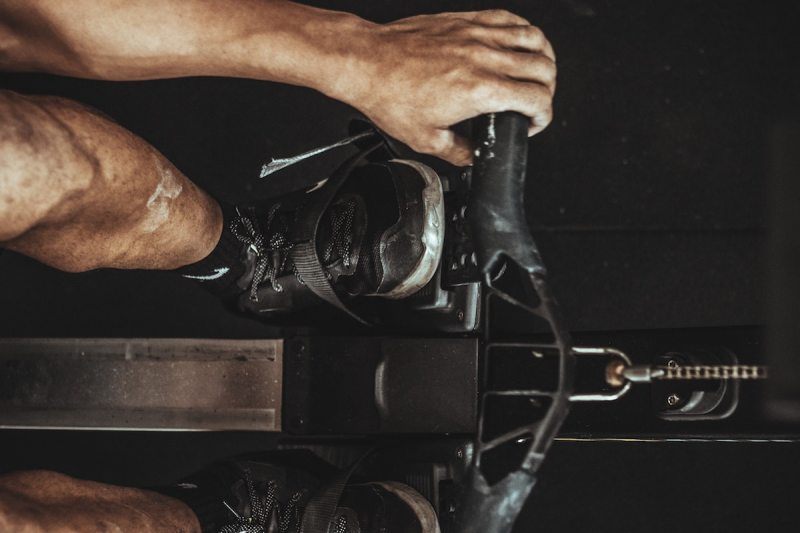Rowing machines are rapidly growing in popularity. It’s easy to see why — they’re a whole-body workout with massive endurance benefits. As a trainer, I personally recommend them to my clients all the time because rowing is a great form of low-impact cardio. However, it’s important to learn how to use a rowing machine correctly because improper form can reduce your performance or even lead to injuries.
Whether you’re using the rowing machine at the gym or you have your own rowing machine at home, it’s important to learn about the machine and how to use it. So, let’s get started!
What is a rowing machine?

A rowing machine imitates the motion of rowing a boat. It has a wide handle attached to a long cable in front of the seat. The user sits on the seat and pulls the handle towards them with both hands, and the cable provides tension.
Rowing machines work out your whole body, not just your arms. You push off the machine with your feet while you pull back, and use your core and your back in the stroke as well. These machines are fantastic for targeting numerous muscles simultaneously.
What are the benefits of using a rowing machine?

Cardiovascular health
Rowing is a challenging cardio exercise. A study of people on competitive boat-rowing teams found that “Competitive rowing challenges most systems in the body, including pulmonary function and circulatory control.” Competitive rowing requires much, much more time spent rowing than just using a machine once in a while, but the finding still shows that the rowing motion is a great cardio exercise that forces your body to work hard.
Full-body workout
As mentioned briefly above, the rowing motion involves using your whole body. You pull back with your arms but also with your back and your core, and you push with your legs. This means that the benefits of rowing will include strengthening not just your arms but your entire body. It also makes rowing a very efficient workout since you can work all parts of your body at once.
Low-impact exercise
Unlike cardiovascular exercises like running, which involve a lot of force on your bones and joints, rowing is very low-impact. It’s good for older people with weaker joints, and it means a much lower chance of injury for everyone.
How to use a rowing machine correctly

- Sit down on the rowing machine and place your feet on the footplates.
- Adjust the foot straps until they are snug so your feet will not slip out.
- Set the resistance. It should be set fairly low when you’re starting out, but you can increase it over time as you become more comfortable with the machine.
- To start, sit with your knees bent, leaning slightly forward, and your arms extended all the way. Grip the handle with an overhand grip and your hands in line with your shoulders.
- When you pull back, push off with your legs first, extending them fully and keeping your arms straight.
- Once your legs are fully extended, lean back slightly, but not very far.
- Pull the handle in towards your ribs. Keep your wrists straight and your elbows close to your body.
- Release in the opposite order; start by extending your arms, then lean forward, then bend your knees to return to the starting position.
Tips for improving speed and power

The most important way to improve your power is to use your legs. Most of the power in the rowing movement comes from your legs. If you don’t put much focus on them, you’ll fall far short of your real ability.
Make sure you’re following the correct form and technique. You’ll be much weaker if you’re using the incorrect form. You should also pay attention to your breathing and getting enough oxygen for this intense activity. And make sure to drink plenty of water.
Don’t focus too much on speed, especially at first. Once you’re used to the machine, you might want to start counting your stroke rate, which is how many strokes you do per minute, but don’t do that when you’re just starting out. Trying to rush is an easy way to ruin your form and get injured.
Common mistakes to avoid

There are a few common mistakes that people make on a rowing machine. One is to try too hard to rush. You want to focus on a smooth, controlled motion, not on speed.
You should also try to use a relaxed grip on the handle. You need to grip it firmly enough that it doesn’t slip, of course, but not so tight that it strains your wrists and forearms. Also, make sure to follow the correct sequence — push with your legs first, then lean your body back, then pull with your arms, and release in the opposite order.
Frequently asked questions

Can you lose belly fat on a rowing machine?
A rowing machine can definitely help you lose weight. It’s a high-intensity, whole-body workout that burns tons of calories. Exercise burns fat throughout the body, so you won’t lose fat only on your belly. However, you can definitely see dramatic weight loss results if you are consistent and eat within a calorie deficit.
How long should a beginner use a rowing machine?
A basic rowing machine workout for a beginner might only be ten minutes on the rowing machine, plus some time spent warming up, cooling down, and stretching. After a few weeks, you’ll be able to increase the time to 20 or 30 minutes.
How do you know if you are rowing correctly?
There’s no obvious way to tell. If you’re worried about whether you’re using proper form, you can set up a camera to film yourself and compare it to people demonstrating how to use the machine on YouTube.




